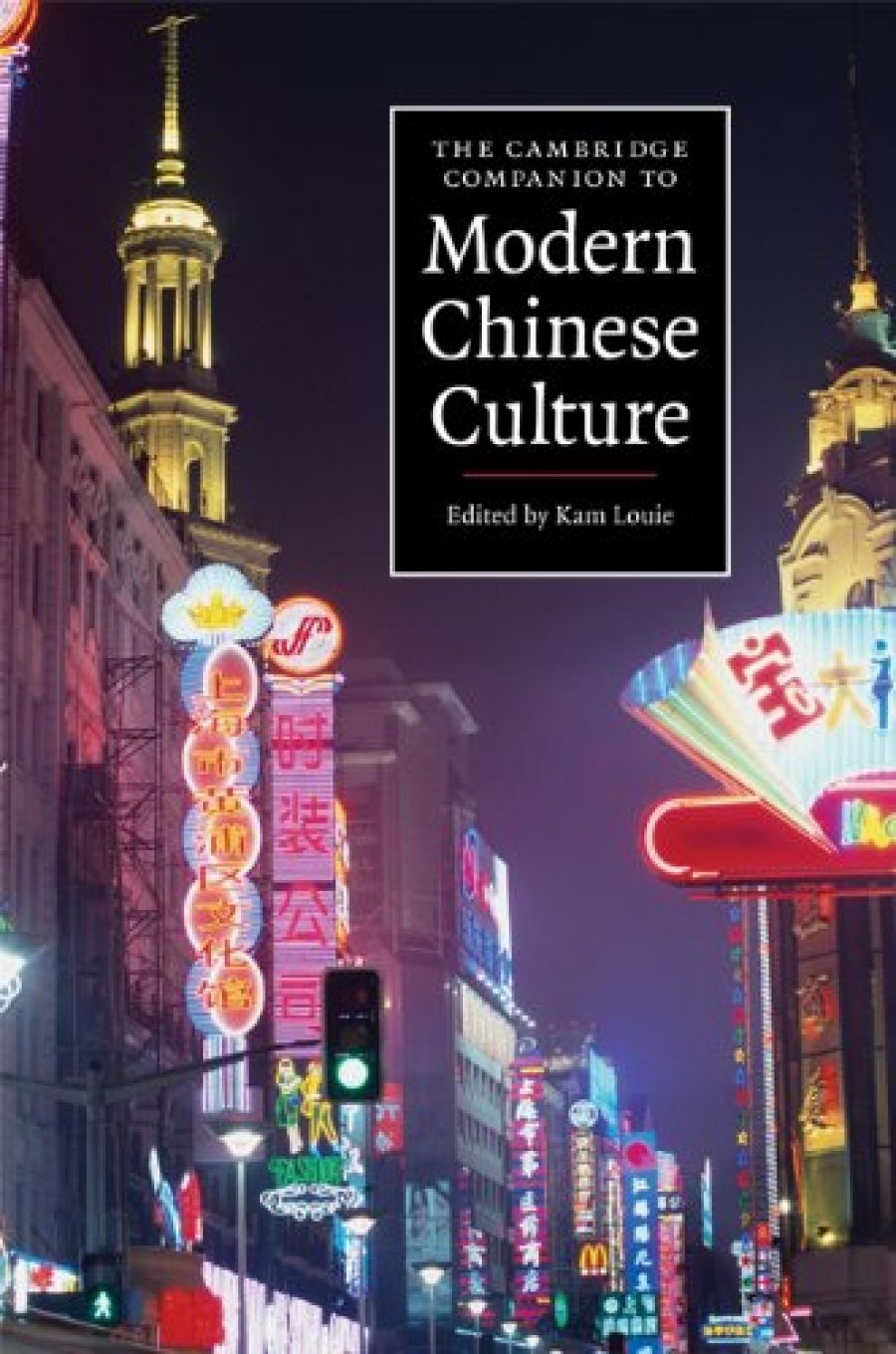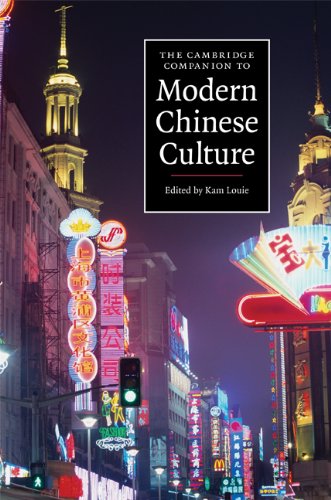
- Free Article: No
- Contents Category: Cultural Studies
- Review Article: Yes
- Article Title: Chinese ferment
- Online Only: No
- Custom Highlight Text:
Imagine a street with a neo-Gothic church, a fish and chip shop, and bronze statues of Winston Churchill, Florence Nightingale, and Shakespeare. Someplace in England? No, it’s Thames Town, a satellite on the outskirts of Shanghai. German, Czech, Spanish, Scandinavian and American suburbs are also planned, to cater to the new Chinese middle class, for many of whom, like the Chinese for most of the twentieth century, ‘modern’ equals ‘Western’. Or recall your local Chinatown, with its ‘Chinese’ shops and restaurants, curved roof façades and resident diaspora, many of them convinced that they are preserving the ‘real’ Chinese culture, now lost in the mainland’s twentiethcentury convulsions. How does each of these represent modern Chinese culture?
- Book 1 Title: The Cambridge Companion to Modern Chinese Culture
- Book 1 Biblio: CUP, $90 hb, 400 pp
- Book 1 Cover Small (400 x 600):

- Book 1 Cover (800 x 1200):

In his thoughtful introduction, Kam Louie, Dean of Arts at the University of Hong Kong, threads his way through such images, and the impact of the 1919 May Fourth Movement’s elevation of ‘Mr Science’ and ‘Mr Democracy’, the domination of Marxism with its ‘Chinese characteristics’, and proclamation in the 1980s of ‘the return of New Confucianism to its homeland’, to try to define ‘modern’ and ‘Chinese’, as well as ‘culture’.
It is a formidable task, assisted by a first-rate group of international scholars dealing with their specialities in seventeen illuminating chapters. The chapters are fairly short (between about 8000 and 10,000 words), and lucidly chronological, allowing a fluid reading of a developing story. In Kam Louie’s words, ‘Rather than attempting to be comprehensive ... all contributors show to varying degrees how their subject matter has changed since the beginning of the twentieth century’.
Although their styles differ, each author follows this pattern with remarkable conformity. Whether reading about religion, literature, cyber-culture, cinema, or socialism, the discussion falls into quickly recognisable periods: the ferment of the early twentieth century, war and revolution, the Maoist years, and the current blending of tradition with globalisation. As Peter Zarrow points out (in ‘Social and Political Developments’), one reason that the post-1980s reforms and development of a market economy proceeded so smoothly was that ‘the Maoist institutions had barely lasted a generation: people had not forgotten all the complex informal institutional arrangements necessary for trade’.
They also remembered certain kinds of freedoms, and many of these exist today, as long as they are not too political. All sorts of clubs, from ballroom dancing to chess, now flourish with barely any supervision. Religious groups and NGOs advocating anything from women’s rights to organic farming are monitored but ‘tolerated’. However, a group like the Falun Gong, an offshoot of the ancient tradition of qigong, whose leader claimed mystical powers and whose followers numbered in the millions, was outlawed in 1999 as a ‘heretical cult’ reminiscent of those forming the core of the nineteenth-century Taiping and Boxer Rebellions, and of the ancient belief that mass followings of heterodox leaders presage the end of dynasties.
Similarly, there is a hierarchy of permitted criticism: ‘academic journals are freer than newspapers, and newspapers are freer than films or pop music’, while the Internet is intensely policed. Alliances between intellectuals and workers are especially threatening to the government, particularly at times like these when millions of migrant workers and peasants who inundated the cities looking for jobs are being forced back to the countryside by the economic downturn. The new ‘consumer patriotism’ might wane when times are tough. Another downside of China’s astounding economic growth since the 1980s has been the ‘systematic pollution of air and water’ in the countryside as well as the cities.
In several chapters, there is a fascinating discussion about the meaning of ‘China’ in the national debate. The desire to include overseas Chinese has encouraged an emphasis on ethnically Han people, but the significance of minorities such as the Tibetans and Taiwanese, as well as within China proper, pushes the definition toward the territorial. Among the Han alone, there are eight major spoken languages, all mutually unintelligible. Although minorities comprise less than nine per cent of the population, they number ninety-one million people, occupying nearly three fifths of China’s total territory, including most of the border regions. And forty-six per cent of the minorities are designated as poor. The complications include groups such as the eighteen million-strong Hui, regarded on Taiwan as Han who practise Islam, but on the mainland as either ‘half Han’ or selftermed ‘Islamic’, but who may or may not practise Islamic dietary restrictions and other markers.
To William Jankowiak (‘Ethnicity and Chinese identity’), most Chinese choose national rather than ethnic identity as ‘the primary source of emotional identification’, which, added to consumer patriotism, makes a powerful connection with the nation-state. He cites reactions to the accidental Belgrade embassy bombing in 1999 and the Hainan spy plane incident in 2001 (at the time, most Western media considered the street demonstrations to be ‘engineered’), but if he had written his piece after the Olympics, he would certainly have focused on the Olympic Torch relay as a primary example of national fervour, induced or not.
The chapter entitled ‘Physical Culture, Sports and the Olympics’ (Susan Brownell) is among the most fascinating. The European colonisers carried the banner of Western civilisation, partly defined by Greek athletics and the Olympic Games. They considered athletics to be ‘incompatible with Oriental despotism and the perceived spiritual decadence of the Orient’, and their sinologists equated the Chinese Imperial Examinations with the Olympics as embodying the essence of their respective characters: the West as a manly athlete. China an effeminate intellectual. (The term ‘sinologist’ was criticised by the New Confucians in the 1950s as describing either missionaries wanting to convert China, those interested in relics of dead civilisations or practitioners of realpolitik without genuine understanding of Chinese culture.) Neither Westerners nor Western-influenced Chinese reformers considered as sport traditional Chinese activities such as acrobatics, martial arts, qigong, dragon boat racing, imperial court wrestling, or Manchu horsemanship.
This perpetuated the idea of China as ‘the sick man of Asia’, and many Chinese criticised their culture for its lack of a sporting tradition. ‘Thus, sports became a key symbol in China’s quest for modernity.’ And although it was a sport – ping pong – which in 1971 renewed China’s contact with the West (Chinese propagandists called it ‘the little globe that moved the big globe’), it was only in 1980 that China was readmitted to the IOC (it withdrew in 1959 over the recognition of Taiwan). The nation’s emotional intensity toward the Beijing Olympics includes the paradox that the successful translation of a Western symbol has made China not Western but global, and fervently nationalistic.
As a reference for most things Chinese (there is no contemporary political detail, in keeping with its longer view), this book is hard to put down once dipped into. Only two of the seventeen chapters, those on gender and Confucianism, occasionally lapse into academese, and they all contain riveting insights and intriguing trivia. (Did you know that the first play performed in ‘modern’ Chinese was Uncle Tom’s Cabin, and that it was put on in Tokyo?). There is a detailed chronology from 1895 to 2008, a list of abbreviations, a comprehensive index, and a sixteen-page appendix of Chinese phrases with pinyin pronunciation guides to English translations. Each chapter concludes with a guide to further reading.
A few small quibbles include the disappointing illustrations (the book’s only illustrations) in the chapter on art (‘Revolutions in Vision: Chinese Art and the Experience of Modernity’, by David Clarke). Muddily printed, too small, and in black and white, they do little to illuminate the text’s references to them. Better none at all, than these.
It has taken eight of the Cambridge Companions to modern national cultures to get around to China, obviously less of a focus in Britain than in Australia. Already we have Companions to America, Ireland, Latin America, France, Italy, Germany, Russia, and Spain. Apart from the ring-in Latin America, the geopolitical choices are understandable. But if it is about time, it is also worth waiting for. As a primer for the non-specialist reader, it is hard to think of a better introduction to the complexities and excitements of a modernising China.


Comments powered by CComment